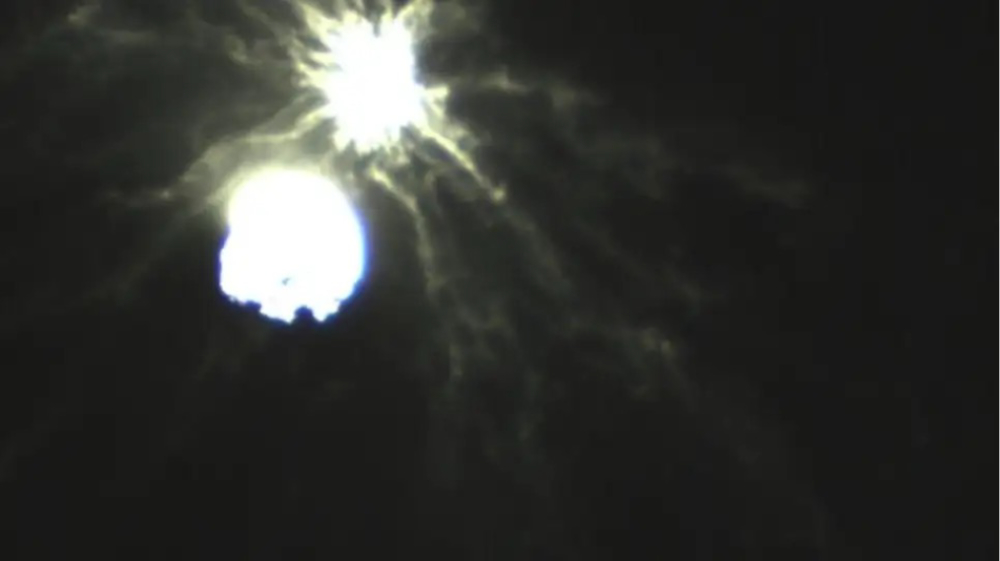Impact!
NASA probe successfully hits asteroid


On 27 September 2022, NASA staff cheered as they watched their $325 million spacecraft crash at some 6.1 km/s (13,500 mph) into Dimorphos, a moon orbiting the asteroid Didymos. The Double Asteroid Redirection Test (DART) spacecraft was designed to assess the potential of a spacecraft impact to deflect an asteroid through transference of momentum.
It seems the popular 1998 movies Armageddon and Deep Impact were not too farfetched. The idea is that if an asteroid is calculated to be on its way to impact Earth, it could be diverted in time. Early observations from ground-based telescopes indicate the DART mission successfully shortened the orbital period of Dimorphos by 32 minutes, from an initial 11 hours and 55 minutes.1
A dangerous asteroid impacting Earth is possible. We are constantly bombarded by space material.2 The vast majority of the meteorites which hit Earth today are asteroids. Asteroids are rocky bodies that orbit the sun, ranging from 1 m (3 ft) in diameter to dwarf planets almost 1,000 km (600 miles) in diameter. Dimorphos is 163 m (540 ft) long, while Didymos is 4–5 times larger (fig. 2).

Out of the 1.1 million known asteroids,3 the vast majority are found in the main asteroid belt between Mars and Jupiter, where they present no threat to Earth. However, there are asteroids and comets that orbit much closer to us. Since 1988, 29,000 near-earth objects (NEOs)4 have been identified and catalogued by NASA.5 Because there are far fewer large ones than small, larger impacts are much less likely.
Roughly every 10 years, a 10-metre (35-ft) diameter meteorite with killing potential hits Earth. These rarely cause a problem, though, because most fall into, or explode over, the sea or the desert; people inhabit a relatively small area of Earth’s surface.6 An exception to this was on 15 February 2013, when a 20 m (66 ft), 11,000-tonne meteor exploded over the Russian city Chelyabinsk, with an energy 30 times greater than the Hiroshima nuclear bomb. Fortunately, the explosion was 15 miles (24 km) high, so it killed no one, even though it wounded over 1,200 and shattered glass.
Meteorites bigger than 1 km in diameter will have devastating effects no matter where they impact. We know that much larger meteorites have hit Earth in the past by the 190 identified impact craters. Their kinetic energy is so great that they vaporize on impact. The most famous is Mexico’s Chicxulub crater, popularly blamed for dinosaur extinction.7
Most large craters are in Flood rocks, so the impact rate was much higher than for the evolutionary scenario which spans more than 2 billion years. Even with this intensity of bombardment, biblical history more readily explains the survival of life, as the water covering Earth lessened the impacts’ effects.
We can be sure that if there is such an event before the Lord’s return, humans will not be wiped out. God promised in Genesis 8:21–22:
I will never again curse the ground because of man, for the intention of man’s heart is evil from his youth. Neither will I ever again strike down every living creature as I have done. While the earth remains, seedtime and harvest, cold and heat, summer and winter, day and night, shall not cease.
References and notes
- NASA confirms DART mission impact changed asteroid’s motion in space, nasa.gov, press release, 12 Oct 2022. Return to text.
- Asteroid Fast Facts, nasa.gov, acc. 6 Oct 2022. Return to text.
- Asteroids: overview, solarsystem.nasa.gov, 19 Apr 2022. Return to text.
- A solar system object with its closest approach to Earth less than 1.3 AU (astronomical units; 1 AU is the distance from the sun to us). Return to text.
- NEO Earth Close Approaches, cneos.jpl.nasa.gov, acc. 6 Oct 2022. Return to text.
- 98% of the planet is unpopulated or very sparsely populated. Return to text.
- Sarfati, J. and Tay, J., Did a Chicxulub impact wipe out the dinosaurs? creation.com/chicxulub, 10 Apr 2021. Return to text.








Readers’ comments
Comments are automatically closed 14 days after publication.